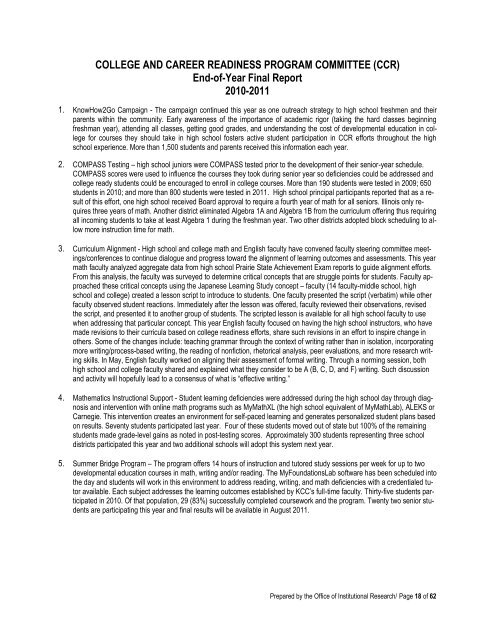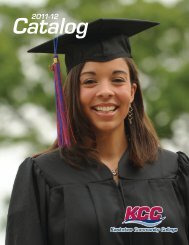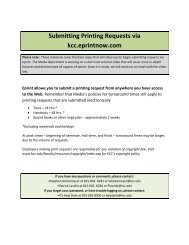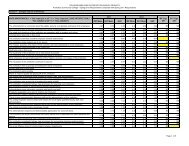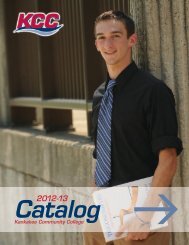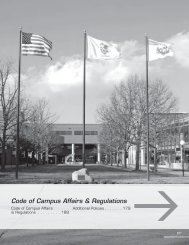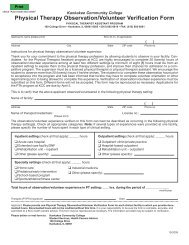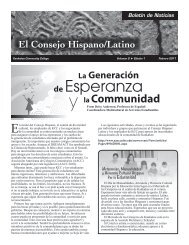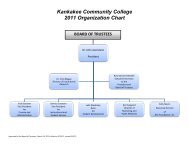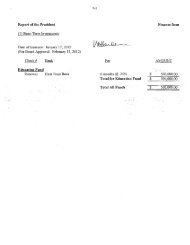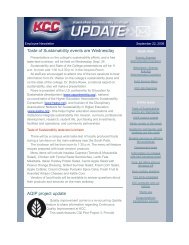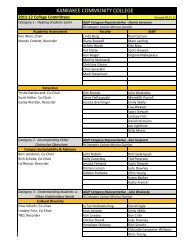2011 Annual Report - Kankakee Community College
2011 Annual Report - Kankakee Community College
2011 Annual Report - Kankakee Community College
You also want an ePaper? Increase the reach of your titles
YUMPU automatically turns print PDFs into web optimized ePapers that Google loves.
COLLEGE AND CAREER READINESS PROGRAM COMMITTEE (CCR)<br />
End-of-Year Final <strong>Report</strong><br />
2010-<strong>2011</strong><br />
1. KnowHow2Go Campaign - The campaign continued this year as one outreach strategy to high school freshmen and their<br />
parents within the community. Early awareness of the importance of academic rigor (taking the hard classes beginning<br />
freshman year), attending all classes, getting good grades, and understanding the cost of developmental education in college<br />
for courses they should take in high school fosters active student participation in CCR efforts throughout the high<br />
school experience. More than 1,500 students and parents received this information each year.<br />
2. COMPASS Testing – high school juniors were COMPASS tested prior to the development of their senior-year schedule.<br />
COMPASS scores were used to influence the courses they took during senior year so deficiencies could be addressed and<br />
college ready students could be encouraged to enroll in college courses. More than 190 students were tested in 2009; 650<br />
students in 2010; and more than 800 students were tested in <strong>2011</strong>. High school principal participants reported that as a result<br />
of this effort, one high school received Board approval to require a fourth year of math for all seniors. Illinois only requires<br />
three years of math. Another district eliminated Algebra 1A and Algebra 1B from the curriculum offering thus requiring<br />
all incoming students to take at least Algebra 1 during the freshman year. Two other districts adopted block scheduling to allow<br />
more instruction time for math.<br />
3. Curriculum Alignment - High school and college math and English faculty have convened faculty steering committee meetings/conferences<br />
to continue dialogue and progress toward the alignment of learning outcomes and assessments. This year<br />
math faculty analyzed aggregate data from high school Prairie State Achievement Exam reports to guide alignment efforts.<br />
From this analysis, the faculty was surveyed to determine critical concepts that are struggle points for students. Faculty approached<br />
these critical concepts using the Japanese Learning Study concept – faculty (14 faculty-middle school, high<br />
school and college) created a lesson script to introduce to students. One faculty presented the script (verbatim) while other<br />
faculty observed student reactions. Immediately after the lesson was offered, faculty reviewed their observations, revised<br />
the script, and presented it to another group of students. The scripted lesson is available for all high school faculty to use<br />
when addressing that particular concept. This year English faculty focused on having the high school instructors, who have<br />
made revisions to their curricula based on college readiness efforts, share such revisions in an effort to inspire change in<br />
others. Some of the changes include: teaching grammar through the context of writing rather than in isolation, incorporating<br />
more writing/process-based writing, the reading of nonfiction, rhetorical analysis, peer evaluations, and more research writing<br />
skills. In May, English faculty worked on aligning their assessment of formal writing. Through a norming session, both<br />
high school and college faculty shared and explained what they consider to be A (B, C, D, and F) writing. Such discussion<br />
and activity will hopefully lead to a consensus of what is “effective writing.”<br />
4. Mathematics Instructional Support - Student learning deficiencies were addressed during the high school day through diagnosis<br />
and intervention with online math programs such as MyMathXL (the high school equivalent of MyMathLab), ALEKS or<br />
Carnegie. This intervention creates an environment for self-paced learning and generates personalized student plans based<br />
on results. Seventy students participated last year. Four of these students moved out of state but 100% of the remaining<br />
students made grade-level gains as noted in post-testing scores. Approximately 300 students representing three school<br />
districts participated this year and two additional schools will adopt this system next year.<br />
5. Summer Bridge Program – The program offers 14 hours of instruction and tutored study sessions per week for up to two<br />
developmental education courses in math, writing and/or reading. The MyFoundationsLab software has been scheduled into<br />
the day and students will work in this environment to address reading, writing, and math deficiencies with a credentialed tutor<br />
available. Each subject addresses the learning outcomes established by KCC‟s full-time faculty. Thirty-five students participated<br />
in 2010. Of that population, 29 (83%) successfully completed coursework and the program. Twenty two senior students<br />
are participating this year and final results will be available in August <strong>2011</strong>.<br />
Prepared by the Office of Institutional Research/ Page 18 of 62


